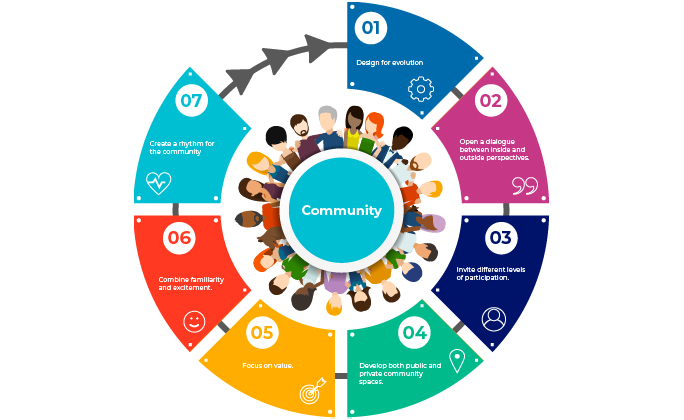Benefits
Learning communities positively impact students’ engagement, retention and overall satisfaction with their student experience (Zhao & Kuh, 2004; Tinto & Russo, 1994). They also:
- Enable peer group support beyond the classroom.
- Increase engagement by allowing for more student involvement.
- Support the development of an academic identity (Wenger, 2000).
- Create a sense of belonging (Tinto, 2000).
Putting it into practice
There are two types of frameworks you can considering when building and implementing learning communities:
Community of Practice
To start developing learning communities, Lave and Wenger’s (1991) social learning concept of communities of practice (CoP) can be adopted and applied in HE (Chilvers, 2014). CoP describes a community of people, joined together by shared interests and a mutual participation in a particular practice. According to Wenger (1998), learning as social participation consists of four aspects that are “deeply interconnected and mutually defining” (p.5) including:
- Practice-learning by doing
- Meaning-learning as experience;
- community-learning as belonging, and
- Identity-learning as becoming
To help you build and sustain a learning community with a CoP approach, you can adopt Wenger, McDermott & Snyder (2002) seven principles of cultivating communities of practice and apply it to you learning and teaching context:
By adhering to these principles, your learning community is probably more likely to be effective for you and your learners. However, it is also important to leave some room for the unexpected, such as having to quickly adapt to hybrid or face to face teaching.
Community of Inquiry
A Community of Inquiry is an online environment that contains core elements which are most crucial for a successful online educational experience: cognitive presence, social presence, and teaching presence. Garrison, Anderson & Archer (2000) model assumes that learning occurs through the interaction of these core elements by the community’s population – teachers and students, and that this interaction forms the educational process.
Social Presence
Social presence is the ability of participants to identify with the community (e.g. course of study). Activities include:
- Share experiences and beliefs in online discussion
- Develop grading rubrics for discussion participation.
Cognitive Presence
Cognitive presence, or the extent to which learners are able to construct and confirm meaning through sustained reflection and discourse.
Teaching Presence
Garrison et al (2000) define teaching presence as the design, facilitation, and direction of cognitive and social processes to achieve learning outcomes. This includes providing direct instruction to students, keeping them focussed and on-track in their learning.
Teachers should aim to:
- Provide frequent opportunities for both public and private interaction with students.
- Establish clear expectations for instructor-student interactions
- Automate testing and feedback (where possible).
Challenges
Consider designing educational experiences and setting the right learning climate with a balance of interactions, following a set of design and cultivation of the community principles and where possible:
- Promote student-content interaction by making learning materials meaningful, structured, logical and varied.
- Promote student-student interaction through online socialisation/discourse, collaboration, and communication
- Promote student-teacher interaction through regular meaningful announcements, discussion forums and constructive/timely feedback on student learning.
- Plan the social and technology architecture by thinking about membership, support and leadership roles as well as the digital tools needed to sustain the community.
- Measure and evaluate both formally and informally.
References
Chilvers, L. (2014). Communities of practice for international students: The role of peer assisted study sessions in supporting transition and learning in higher education. Supplemental Instruction Journal, 1(1), 90-115.
Garrison, D. R., Anderson, T., & Archer, W. (2000). Critical inquiry in a text-based environment: Computer conferencing in Higher education. Internet and Higher Education, 11(2), 1-14.
Schmidt, L. and Miller, J. (2009). Peer assisted study sessions to facilitate transition for international students. The International Journal of Diversity in Organisations, Communities & Nations, 9(5), 13-29.
Tinto, V., and Russo, P. (1994). Coordinated studies programs: Their effect on student involvement at a community college. Community College Review, 22(2), 16–25.
Tinto, V. (2000). What we have learned about the impact of learning communities on students? Assessment Update, 12(2): 1-2, 12.
Wenger, E. (1998). Communities of Practice: Learning, Meaning and Identity, Cambridge: Cambridge University Press.
Wenger, E. (2000). Communities of Practice and Social Learning Systems. Organization 7(2), 225-246.
Wenger, E., McDermott, R. A., & Snyder, W. (2002). Cultivating communities of practice: A guide to managing knowledge. Harvard Business Press.
Help and Feedback
Can you help us improve this resource or suggest a future one? Do you need this resource in an alternative format? Please contact us at cie@liverpool.ac.uk

Learning Communities by Dr Monica Chavez, David Watson & Dr Robert Treharne is licensed under a Creative Commons Attribution-NonCommercial 4.0 International License.

